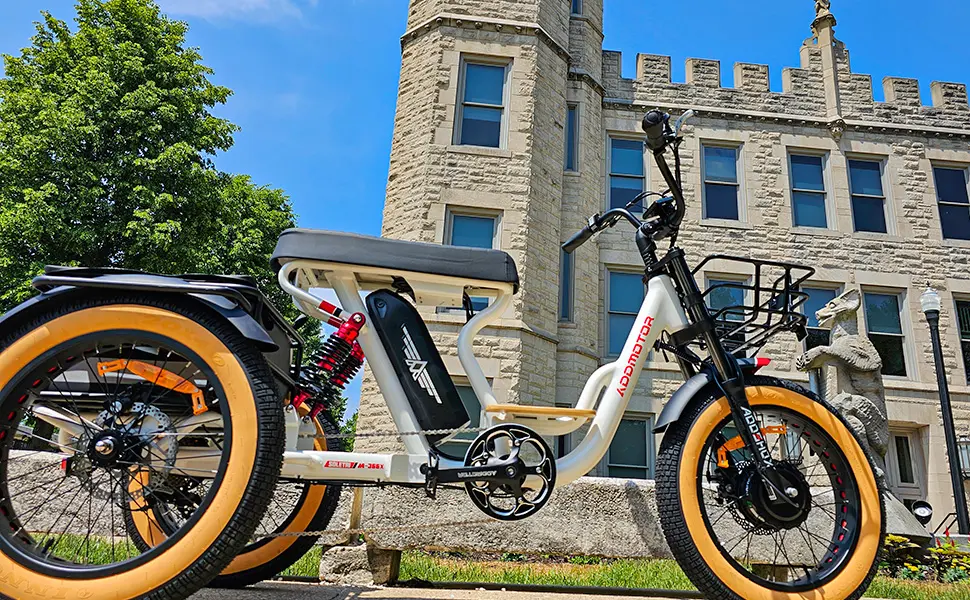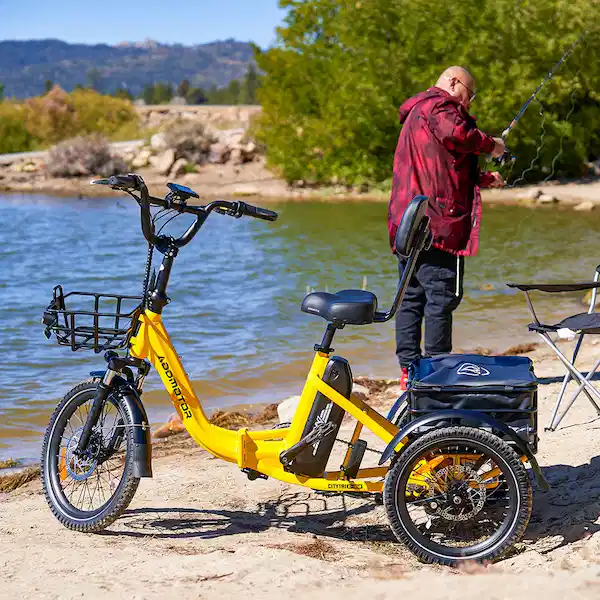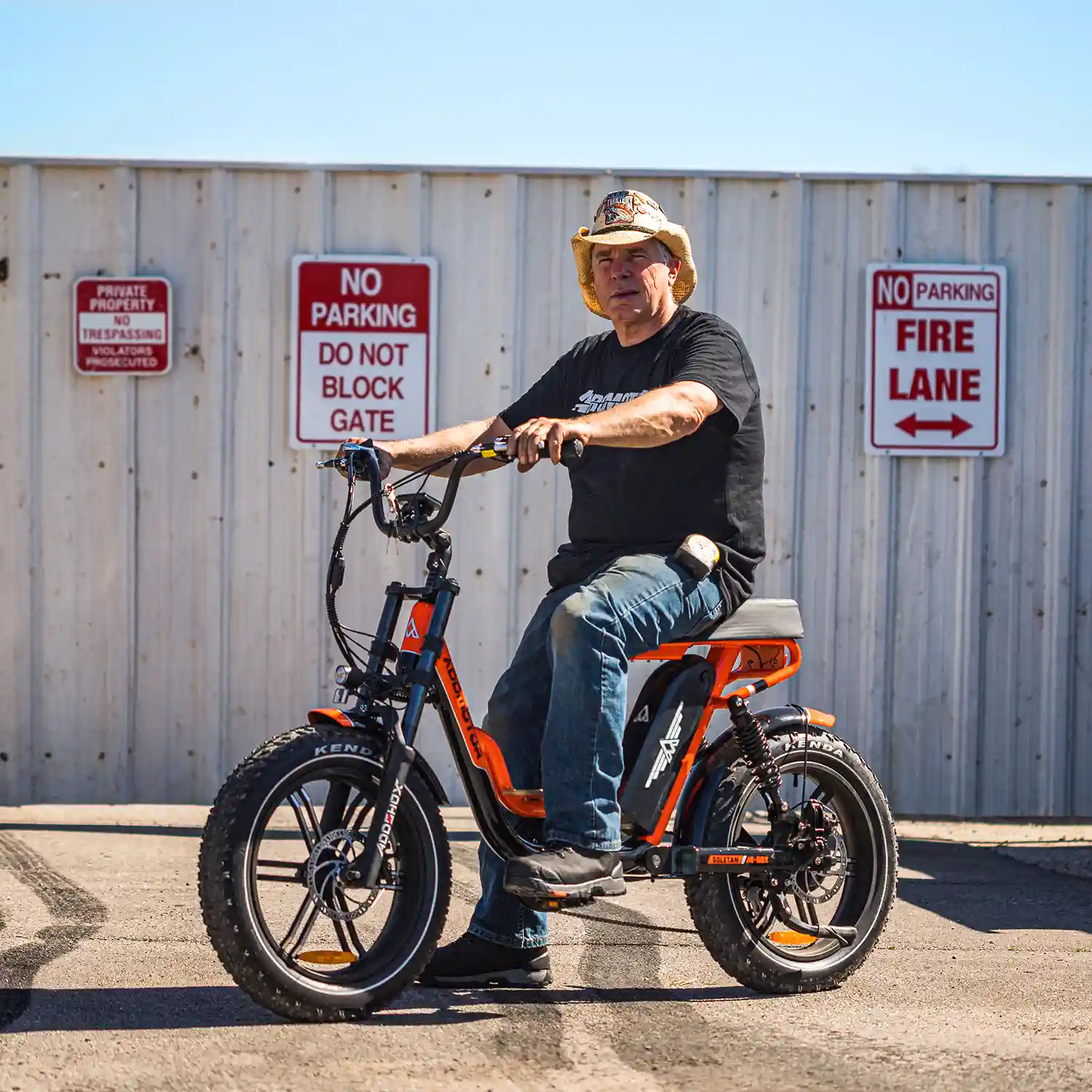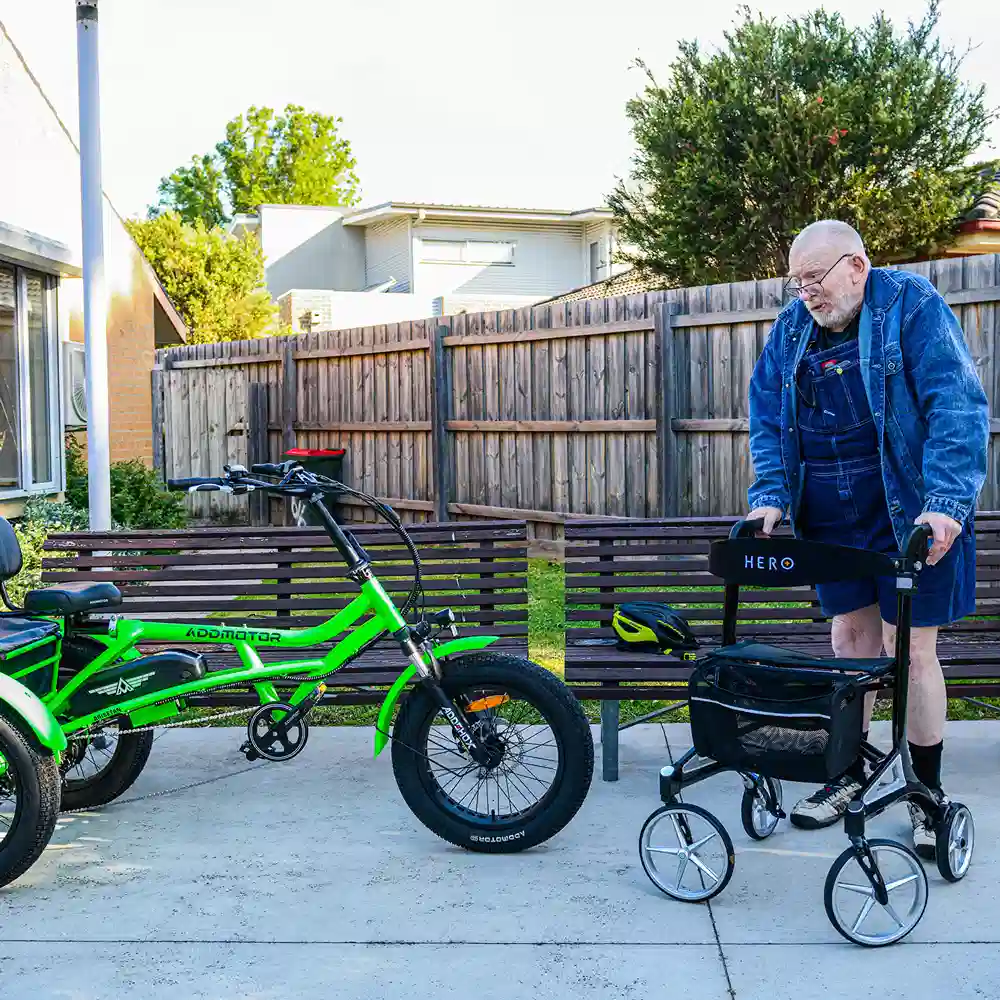What Are the Legal Requirements for Riding Electric Trikes in the USA?
By Addmotor | 20 February 2025 | 0 Comments
It’s tempting to just hop on your e-bike or electric trike (three-wheel electric bike) and take off as soon as it’s assembled, but do you understand the legal requirements that might apply to you?
Electric trike laws can be tricky because there isn’t just one set of rules that covers the entire country. Instead, both federal and state regulations come into play, and these can vary a lot depending on where you live.
In this article, we’ll explain everything you need to know about riding an electric tricycle in the United States.
According to these rules, an electric bike or 3-wheel electric bike is generally treated like a traditional bicycle if:
But here’s the catch: while federal law sets the stage for these definitions, each state can create additional rules. This can include what kind of license you need (if any), minimum age requirements, where you can ride, and more.
So, even if your electric trike is perfectly legal under federal rules, you might still need to meet specific requirements in your city or state.
Here’s a quick overview:
That said, local governments have the right to set specific rules about using motor power on certain paths, so always check city ordinances.
Individuals under the age of 16 can’t operate a class 3 electric bicycle or e-tricycle. They can ride as a passenger, though.
For all e-bikes, riders under 17 and all class 3 e-bike riders must wear helmets. There’s no license or registration requirement for federally defined e-bikes and e-trikes.
16 years is the minimum age limit to operate a class 3 e-bike. Helmet use is mandatory for riders under 16 years and recommended (but not required) for riders over 16. However, local governments can pass their ordinances about sidewalk riding, so it’s wise to check local rules.
Riders must be at least 15 years old to operate a Class 3 e-bike, and individuals under 18 must also wear helmets.
You can generally ride on bike lanes, bike paths, and bike trails where traditional bicycles are allowed, though local restrictions might apply. Public parks and other protected areas may have their own rules.
Children under 16 can only ride class 1 and 2 e-trikes. Riding on public streets, bike lanes, and bike paths is allowed, but sidewalks are off-limit. Multi-use trails are to be used per local laws.
There’s no state-wide helmet law for adult riders, but helmets are required for riders under 18 (and passengers) when operating a class 3 e-trike.
You must be at least 15 years old to operate a class 3 e-bike, and all class 3 riders must wear helmets.
As always, local city ordinances might add their own twist on things. Bicycle trails may have specific speed restrictions, and it's essential to check local trail regulations to ensure compliance.
Helmets aren’t required for adults, but local rules might vary in certain cities or counties.
Pennsylvania riders must also ensure their e-bikes or e-trike weighs less than 100 lbs. They can use DCNR-managed trails and public roads, where traditional bicycles ride unless these areas are marked prohibited. Some e-bikes are allowed on sidewalks, but there may be some restrictions.
Generally, helmets are required for riders aged 16 and 17 and Class 3 riders of any age. Some streets and highways have a speed limit of 30 mph or less. Sidewalks are off-limits unless local laws allow them to be used.
Keep in mind that speed limits, safety gear requirements, and allowed locations can vary, so it’s crucial to check local ordinances if you’re in the city or surrounding counties.
The rules can feel complicated at first, but it boils down to a few key points: make sure your e-trike fits the federal definition if you want to avoid a license and registration, check your state’s specific regulations for age and helmet rules, and respect local guidelines for where you can and can’t ride.
Disclaimer: This blog post is for informational purposes only and should not be considered legal advice. Regulations may change, and readers should consult official sources or legal professionals for the most current information.
Electric trike laws can be tricky because there isn’t just one set of rules that covers the entire country. Instead, both federal and state regulations come into play, and these can vary a lot depending on where you live.
In this article, we’ll explain everything you need to know about riding an electric tricycle in the United States.
Electric Bike Federal Regulations
In the US, federal regulations create a baseline for what’s considered an electric bicycle (which includes electric tricycles, so long as they meet certain criteria).According to these rules, an electric bike or 3-wheel electric bike is generally treated like a traditional bicycle if:
• It has operable pedals.
• It uses a motor of less than 750 watts (approximately 1 horsepower).
• It can reach a maximum speed of 20 mph when powered solely by the motor.
If your e-bike or electric trike meets these specifications, you don’t need to worry about federal requirements like licensing, registration, or following the usual motor vehicle safety standards. In other words, the federal government sees these e-trikes the same way it sees bicycles. This is huge because it means you can usually ride in the same places as regular bikes—like bike lanes or city streets—without the extra red tape of car-like regulations.But here’s the catch: while federal law sets the stage for these definitions, each state can create additional rules. This can include what kind of license you need (if any), minimum age requirements, where you can ride, and more.
So, even if your electric trike is perfectly legal under federal rules, you might still need to meet specific requirements in your city or state.
Introducing the E-Bike Three-Class System
Most states have adopted the “three-class system” for electric bicycles and, by extension, some electric trikes. This system helps distinguish between different e-bikes (and e-trikes) based on how the motor is activated and how fast the bike can go.Here’s a quick overview:
Class 1 Electric Bike:
It comprises electric bikes or e-trikes with pedal-assist mode only, and the motor support cuts off at 20 mph. This means you have to pedal for the motor to kick in, and you won’t get any motor help once you hit the speed limit.Class 2 Electric Bike:
Class 2 e-bikes are equipped with a throttle and can reach a top speed of 20 mph under motor power alone.Class 3 Electric Bike:
It includes pedal-assist-only trikes, but the motor will help you reach up to 28 mph. Because of the extra speed, Class 3 e-bikes are often not allowed on certain bike paths or multi-use trails, depending on state or local regulations.State-by-State Differences
As mentioned earlier, each state can (and often does) have its own rules about electric tricycles. To give you a better idea, here are the main areas where state laws can differ:• Age Requirements: Some states say you have to be at least 16 years old to ride an e-trike, while others might have no age limit (especially for Class 1 e-bikes or e-trikes).
• Helmet Laws: States have different helmet rules. Many require helmets for riders under a certain age, and some are more strict regarding Class 3 e-bikes. In a few places, helmets are required for everyone, no matter what class your e-trike is.
• Licensing and Registration: Most states do not require registering your e-trike or getting a special driver’s license if it meets the federal definition of an electric bicycle. However, some states—like Alaska and North Dakota—make exceptions for higher-powered or faster models.
• Road Usage: Once you’re out and about, the rules about where you can ride vary. In some states, you can use bike lanes, ride on roads where the speed limit isn’t too high, and maybe even use certain bike trails. Other states might restrict Class 3 e-trikes from certain paths or trails because they can go faster.
• Equipment Requirements: Just like bicycles, e-trikes are usually required to have working brakes, front and rear lights or reflectors for night riding, and an audible warning device (like a horn or bell).
Examples of Electric Trike Laws by State
Wisconsin
In Wisconsin, you don’t need a license or registration for your electric trike (except for the city of Madison, which requires registration), and there’s no state-wide helmet rule. You’re free to ride on roadways and in roadway bike lanes. However, if you use the motor while on bike paths or shared-use paths, you might run into local restrictions. Riding on sidewalks is not allowed.That said, local governments have the right to set specific rules about using motor power on certain paths, so always check city ordinances.
Individuals under the age of 16 can’t operate a class 3 electric bicycle or e-tricycle. They can ride as a passenger, though.
Top Features Include:
-
✓ 750 watt rear motor
-
✓ UL 2271 e-bike battery pack
-
✓ Max speed of 20 mph
-
✓ 7 pedal assist modes
-
✓ Torque sensor
-
✓ Full Suspension
California
California requires riders to be at least 16 years of age to operate a class 3 e-bike. The motor should have a maximum power of 750W, and the speed limit is 28 mph on flat ground.For all e-bikes, riders under 17 and all class 3 e-bike riders must wear helmets. There’s no license or registration requirement for federally defined e-bikes and e-trikes.
Florida
In Florida, electric bikes (including e-trikes) that go up to 20 mph and are no more than 750 watts are treated like regular bicycles. The speed limit is 28 mph for class 3 trikes. Riders can use streets, bike lanes, and sidewalks. However, riding on highways may be subject to specific restrictions, so always check local rules.16 years is the minimum age limit to operate a class 3 e-bike. Helmet use is mandatory for riders under 16 years and recommended (but not required) for riders over 16. However, local governments can pass their ordinances about sidewalk riding, so it’s wise to check local rules.
Texas
Texas also aligns with the federal definition for e-bikes and subjects e-trikes to the same traffic law and safety precautions.Riders must be at least 15 years old to operate a Class 3 e-bike, and individuals under 18 must also wear helmets.
You can generally ride on bike lanes, bike paths, and bike trails where traditional bicycles are allowed, though local restrictions might apply. Public parks and other protected areas may have their own rules.
Illinois
Illinois limits electric bicycles to 20 mph per hour on flat ground. It doesn’t require riders to wear helmets, but it’s still recommended.Children under 16 can only ride class 1 and 2 e-trikes. Riding on public streets, bike lanes, and bike paths is allowed, but sidewalks are off-limit. Multi-use trails are to be used per local laws.
Colorado
Colorado uses the three-class system and requires Class 3 riders to be at least 16. Class 1 and Class 2 e-bikes (and e-trikes) can generally be ridden on regular bike paths and pedestrian lanes, but local jurisdictions may have specific restrictions, such as on some mountain bike trails. Class 3 e-bikes are restricted from bike paths and pedestrian lanes but are allowed on streets and highways.There’s no state-wide helmet law for adult riders, but helmets are required for riders under 18 (and passengers) when operating a class 3 e-trike.
Georgia
Georgia treats e-bikes and e-trikes under 750 watts as bicycles. That means no license or registration is needed.You must be at least 15 years old to operate a class 3 e-bike, and all class 3 riders must wear helmets.
As always, local city ordinances might add their own twist on things. Bicycle trails may have specific speed restrictions, and it's essential to check local trail regulations to ensure compliance.
Pennsylvania
Pennsylvania allows electric bikes and trikes under 750 watts and 20 mph to be operated without a license. However, riders must be at least 16 years old.Helmets aren’t required for adults, but local rules might vary in certain cities or counties.
Pennsylvania riders must also ensure their e-bikes or e-trike weighs less than 100 lbs. They can use DCNR-managed trails and public roads, where traditional bicycles ride unless these areas are marked prohibited. Some e-bikes are allowed on sidewalks, but there may be some restrictions.
Arizona
Arizona does not require a license or registration for low-speed electric bikes and trikes under 750 watts and 20 or 28 mph. Class 1 and Class 2 e-bikes are allowed on bike paths and bike lanes, but Class 3 e-bikes are generally restricted to roadways, bike lanes, and paths adjacent to roadways. Riders should follow traffic laws similar to regular bicycles.New York
New York recognizes Class 1, Class 2, and Class 3 e-bikes (and e-trikes) in most areas.Generally, helmets are required for riders aged 16 and 17 and Class 3 riders of any age. Some streets and highways have a speed limit of 30 mph or less. Sidewalks are off-limits unless local laws allow them to be used.
Keep in mind that speed limits, safety gear requirements, and allowed locations can vary, so it’s crucial to check local ordinances if you’re in the city or surrounding counties.
Final Words
Electric trike laws are there to make sure riders, pedestrians, and car drivers can share the road (or trail) safely.The rules can feel complicated at first, but it boils down to a few key points: make sure your e-trike fits the federal definition if you want to avoid a license and registration, check your state’s specific regulations for age and helmet rules, and respect local guidelines for where you can and can’t ride.
Disclaimer: This blog post is for informational purposes only and should not be considered legal advice. Regulations may change, and readers should consult official sources or legal professionals for the most current information.
Leave a Reply
Your email address will not be published.Required fields are marked. *
Latest Stories



_1739850786.webp)

